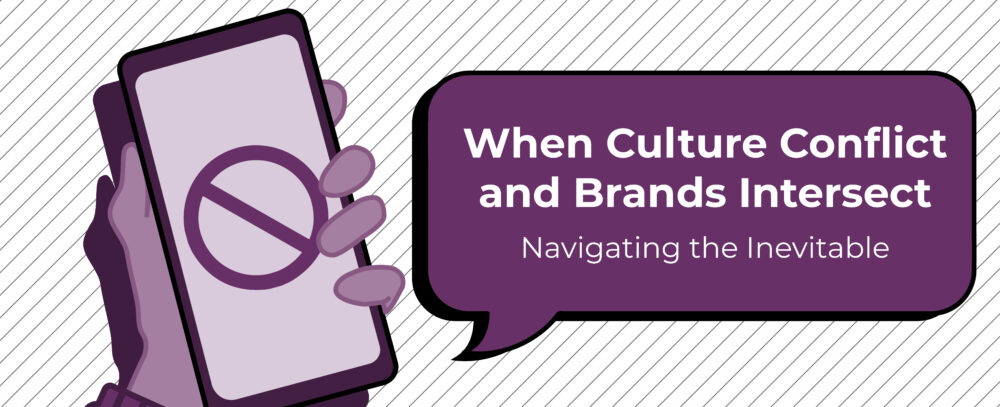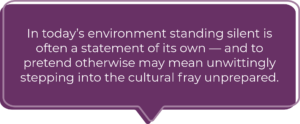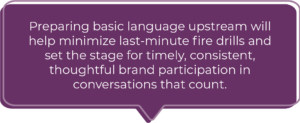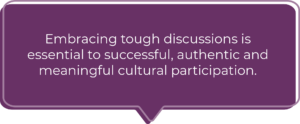The Benefits and Risks of Communicating Authentic Brand Values in a Polarized World

Conventional wisdom says that every brand should act like a media brand, maintaining relevancy by staying part of the always-on conversation where cultural energy gathers. At the same time, consumers are ever more attentive to the values and purpose behind the brands they shop,.
It seems intuitive that having a strong point of view on key cultural touchpoints such as social justice, environmental sustainability, inclusivity and beyond is an ideal way to showcase your brand’s authentic, values-based commitments and exert influence on key topics that matter to many stakeholders.
However, in todays polarized landscape — where broad diversity of opinion reigns — organizations seeking to promote their organization’s unique values run the risk of stumbling into seismic fault lines along America’s cultural divide with the potential for reputational fallout for their brand.
At Wilks Communications Group, helping brands navigate today’s complex cultural landscape with integrity and skill is one of our most challenging responsibilities. Every organization and stakeholder group are different, and the societal norms that give context to our work are more volatile, highly charged and fragmented than ever.
Indeed, the only answer that holds constant at the intersection of brand reputation and culture is that there are no easy answers. We do, however, rely on a few key practices and principles to foster equilibrium in today’s choppy cultural waters.
Standing silent is not always the brand-safe path.
When it comes to hot button issues, many leaders’ first instinct is to focus exclusively on selling a great product and leave the rest to others. In today’s environment, however, standing silent is often a statement of its own — and to pretend otherwise may mean unwittingly stepping into the cultural fray unprepared.

We often counsel clients that while you can’t take a stance on every issue that makes the headlines, you likely must make a statement on some if you hope to preserve your brand’s relevancy in the eyes of employees, consumers and other critical stakeholders. Precisely which issues merit brand action are distinct depending on your organization’s values, and beyond the scope of this article. But as a basic principle, we advise joining the conversation selectively, in areas where your operations or internal values are clearly aligned with those of your stakeholders.
We also remind clients that the time to think deeply about this subject is now; not after an external crisis suddenly forces the point. We recommend periodically assessing the evolving cultural landscape, determining whether it’s best to lead, follow, or stand aside on key issues, consistent with your brand. Be prepared with foundational messaging that’s pre-vetted and approved on issues where you would expect to comment. While of course real-time communication will always require some nimble adaptation, preparing basic language upstream will help minimize last-minute fire drills and set the stage for timely, consistent, thoughtful brand participation in conversations that count.

There’s no way around tough internal discussions.
If the cultural positions of a brand could simply mirror the personal perspective of the founder or CEO, our work would be much simpler. (And some outlier organizations such as Patagonia, Chick-fil-A and Penzeys Spices truly do live this vision.) Most brands, however, embody a complicated, often very large internal ecosystem that must balance competing agendas. As a result, responsible brand leadership often requires clear-eyed assessment of uncomfortable conflicts, contradictions, and trade-offs.
Reluctance to tackle internal divisions about culture and brand values is common among organizational leaders, and completely understandable. But embracing these discussions is essential to successful, authentic and meaningful cultural participation. First, we must engage in this work if we hope to steer clear of unwanted or inadvertent controversy. Second — and more importantly — digging deep into values and realistically assessing organizational appetite for reputational risk is the only way to achieve a true cultural leadership stance that is a hallmark of today’s most compelling brands.

Brand blunders may happen, but consumers forgive.
The good news is that while cancel culture remains an active force in society, and brands sometimes fall into the crosshairs of groups that oppose their stance on controversial topics, most business leaders agree that standing up for your brand’s values is worth the risk. In addition, managers who spend time building trustworthy, purpose-driven brands and demonstrating consistent responsible citizenship will be able to sustain consumer trust. (Which also happens to be the ultimate defense against reputational damage, when the road gets rocky.)
The fact is that threats of consumer boycotts have been around for decades. They make the nightly news, but the momentum quickly fades away, especially if the organization in question accepts responsibility, demonstrates contrition if it’s warranted, and takes appropriate action to remedy the problem. In the words of a recent study by Forrester, the best response in this type of situation is to ”own up to mistakes, push back on misinformation and wait out the noise.” That same study points out that nearly half of U.S. online adults say they would go back to doing business with a “canceled” brand following a public apology.
As we all know, every brand is unique. Our advice for clients seeking to protect their brand in a cancel culture world is to focus on building loyalty among stakeholders over the years by leaning into your organization’s authentic values and collective ethos in telling your story. In that way you will build, grow and retain their trust, which will pay off in a crisis.
At Wilks Communications Group, we specialize in helping brands and organizations successfully find and maintain their place in today’s cultural conversation. From foundational strategy to intensive crisis communications, we offer a comprehensive toolkit that sets brands up for success in an ever-changing market. If you’d like to learn more about how we can support your goals, let’s connect.